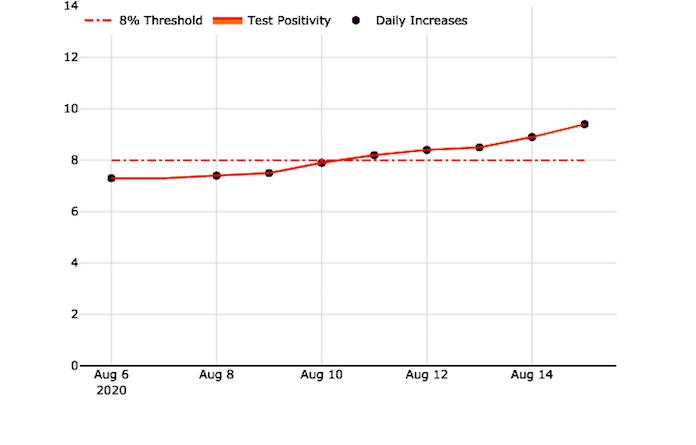Monroe County reports new COVID death, at warning level again

With word spreading Monday afternoon of possible new restrictions being imposed due to rising coronavirus cases, Gov. JB Pritzker’s office assured that current mitigation efforts imposed last week in the metro east will remain in place until the 14-day evaluation period expires.
“We need to work as a team to get the positivity rate down by Sept. 1,” Allison Flood, Government Affairs Manager for Pritzker’s office, stated in an email to metro east mayors.
Gov. Pritzker and the Illinois Department of Public Health announced new COVID-19 mitigation efforts for the seven-county metro east region (Region 4) last week after consecutive days of test positivity rates at 8 percent or higher.
“Region 4, which is already operating under additional mitigations, continues to report increasing COVID-19 positivity rates and will have one more week at their current mitigation level before the state must move to impose further mitigation in the region,” a press release from the governor’s office states.
Some mayors in St. Clair County reported that state health officials informed during a Monday call them of possible new regulations that included no indoor dining at restaurants.
The IDPH on Tuesday reported a 9.8 percent positivity rate for the metro-east, the highest in the state.
Monroe County Health Department Administrator John Wagner reported another death related to COVID-19 on Friday, bringing the county’s total deaths from the virus to 14.
Wagner said the deceased was a woman in her 70s who went to the hospital and died shortly thereafter.
“We don’t know the exact details on this yet, but COVID was detected either soon before or right after death,” he said before noting the woman could have died from other causes and just tested positive for coronavirus.
If that is the case, the state will adjust its numbers accordingly when it has the facts and time to do so.
Also on Friday, the IDPH announced that Monroe County is again at the warning level for coronavirus.
There are 20 counties on the list this time, which uses data from the week of Aug. 9. St. Clair and Randolph counties are also on the list, as are fellow metro east counties Madison and Clinton.
“These counties saw cases or outbreaks associated with weddings, businesses, neighborhood gatherings, parties, long-term care facilities and other congregate settings, travel to neighboring states, bars, sports camps and spread among members of the same household who are not isolating at home,” the IDPH stated in a press release. “Cases connected to schools are also beginning to be reported.
“Public health officials are observing people not social distancing or using face coverings. Additionally, there are reports of individuals who are ill attributing their symptoms to allergies or other illnesses or not being forthcoming about their symptoms or close contacts.”
For the week the data measures, Monroe County had 207 cases per 100,000 people (the goal is 50 or fewer), a test positivity rate of 9.5 percent (the goal is less than or equal to 8 percent) and performed 253 tests (the goal is to do enough tests to meet the positivity rate goal).
The county met the other metrics of number of deaths, emergency department visits and hospital admissions for COVID-19-like illnesses and ICU bed availability. For more on the IDPH coronavirus metrics, click here.
The metro east region – including Monroe County – was placed under new restrictions to mitigate the spread of coronavirus after it experienced three consecutive days of a positivity rate above 8 percent.
The state said when it debuted its mitigation plan last month that would be one metric to trigger mitigation measures being imposed.
“Throughout the COVID-19 pandemic, I have made it clear that neither arbitrary dates on a calendar nor political pressure will dictate Illinois’ efforts to protect our people. If the data shows we need to go backwards in our reopening, I won’t hesitate to tighten restrictions to protect our collective health,” said Pritzker. “Working with local officials in the metro east region and across the border in St. Louis, we are implementing stricter mitigations that account for the unique factors in this region… If you haven’t been taking this seriously yet, now is the time to start.”
The new mitigation measures last until Sept. 1.
Under these restrictions, bars must close at 11 p.m. like they currently do in St. Louis. There will be no ordering, seating or congregating area at the bar, all bar patrons must be seated at tables, tables must be six feet apart, patrons may not congregate indoors while waiting for a table or to order, customers are not permitted to dance or stand indoors and reservations will be required for each party.
Restaurants must also close at 11 p.m., have six feet between tables and prohibit standing or congregating indoors or outdoors while waiting for a table or exiting. Restaurants will also limit tables to six people or fewer and require reservations for each party.
Finally, meetings and social gatherings are limited to 25 guests or fewer or 25 percent of overall room capacity, all reception halls will be closed, party buses will be prohibited and gaming venues and casinos will close at 11 p.m. and be limited to 25 percent capacity.
“Your community is facing concerning trends in positivity rates – rates that we aren’t seeing in most of the other areas of Illinois,” Pritzker told metro east residents at a press conference in East St. Louis on Monday. “It is in the best interest of all St. Louis and metro east residents, Illinoisans and Missourians alike, to take action now to bring down the positivity rate.”
If the positivity rate averages less than or equal to 6.5 percent over the two weeks, these measures will be lifted.
If it averages between 6.5 and 8 percent, the mitigations will remain in place. If the positivity rate remains over 8 percent, stricter restrictions will be put in place, such as closing indoor dining and drinking.
“To be clear, although we’re imposing Tier 1 mitigations now, we could be just a step away from additional mitigations if things don’t turn around in the next two weeks,” Pritzker stressed. “That could include the closure of more indoor bars and dining, as well as more stringent steps as deemed necessary by health officials.”
State Sen. Paul Schimpf (R-Waterloo) lambasted the restrictions.
“Gov. Pritzker’s arbitrary and misguided sanctions… come at the worst possible time as communities are attempting to resume school and rebuild their businesses,” he said. “COVID-19 hospitalization rates in these counties remain low with no threat of exceeding medical capacity. Nevertheless, the governor has decided that bar stools, reception halls and groups of 26 or more people are not allowed for the next 14 days. These new restrictions represent an absurd attempt to show that he is ‘doing something,’ but in reality will do little more than to wreak further economic havoc on the families of this region.”
The region has seen three days of hospitalization increases since Aug. 13. It also has 28 percent hospital availability and 41 percent ICU bed availability.
In Monroe County, the coronavirus case total now stands at 414, with 87 new cases reported over the past 14 days.
Twelve new cases were announced Tuesday, six were announced Monday, eight were announced Sunday, four were announced Saturday and Friday, seven were announced Thursday and three were announced Wednesday.
At last count, 41 cases are active and one resident is hospitalized with the virus. The other resident hospitalized with the virus was recently transferred to St. Clair County.
Wagner said the lower number of active cases is just an issue of timing, as the county is still seeing 8-10 new cases a day. He also said he does not expect that to change with Pritzker’s order because the spread of the virus in Monroe County has not been traced back to places like bars or party buses.
“I don’t expect the governor’s order will change our numbers,” Wagner said.
The Backyard Learning Center, located at 715 Remlok Park Drive in Waterloo, is closed for deep cleaning due to COVID cases.
“There are a couple staff that have tested positive and close contacts have been notified for isolation,” Wagner confirmed. “No children (have tested positive) at this time.”
Overall, the Waterloo zip code has had 190 cases (3,033 tests), the Columbia zip code has had 184 cases (1,435 tests) and the Valmeyer zip code has had 20 cases (169 tests), according to the Illinois Department of Public Health.
Wagner said Tuesday that about a quarter of the newest cases are among people in their 20s, with the rest spread among other age groups.
“It’s really split,” Wagner said of the age distribution. “The most is in that younger group.”
Wagner also expressed criticism with the new restrictions during last Monday’s meeting of the Monroe County Board. Read more by clicking here.
The health department has also noticed more people in an even younger age group have started contracting the virus more frequently.
“We are seeing some high-school-age positives,” Wagner said. “It’s not a big number, but something that we never really saw before. We very rarely saw anybody under the age of 20 come up until about three weeks ago. There used to be only one here or there, but now we’re getting a couple a week.”
Although that is the case, as some schools began in Monroe County and others start later this week, Wagner said no teachers or students have tested positive for the virus recently.
Wagner said teachers and students will get COVID-19, but it remains to be seen how many children will be asymptomatic.
Wagner added he will closely monitor if adults seem to be contracting the virus from children in school.
Last week also saw another staff member at Oak Hill Senior Living & Rehabilitation Center in Waterloo test positive for the virus. No residents have contracted the virus at that facility, and the most recently infected staff member has been placed in quarantine.
Wagner said no other nursing homes have had positive cases recently.
“It seems like the nursing homes have a system that’s got a pretty good chance of keeping positive workers from bringing it in,” he said.
St. Clair County has had 5,503 total positive tests and 174 coronavirus-related deaths. A total of 58,477 tests have been performed there.
In Randolph County, there have been 684 total confirmed cases, 151 of which are active. Eight people have died from the virus. A total of 8,443 people have been tested.
Randolph County is also coping with an outbreak at Menard Correctional Center. There have been 41 inmates and 15 staff at that facility who have gotten the virus, according to North County News.
Statewide, there are 223,470 cases of coronavirus and 7,917 deaths, according to the IDPH.
Missouri has recorded 76,636 confirmed cases and 1,440 deaths as of Tuesday. That includes 17,564 cases in St. Louis County and 5,847 cases in St. Louis City, according to the Missouri Department of Health & Senior Services.
Nationally, more than 5.7 million people have contracted the virus, while at least 177,547 people have died.
Worldwide, there are over 23.6 million cases of coronavirus and at least 814,072 COVID-19-related deaths.






